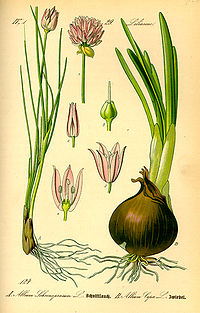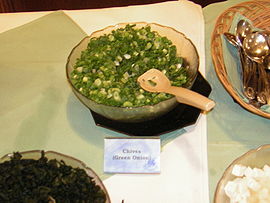
Chives
Background to the schools Wikipedia
Arranging a Wikipedia selection for schools in the developing world without internet was an initiative by SOS Children. Before you decide about sponsoring a child, why not learn about different sponsorship charities first?
| Chives | |
|---|---|
 |
|
| Scientific classification | |
| Kingdom: | Plantae |
| Subkingdom: | Tracheobionta |
| Division: | Magnoliophyta |
| Class: | Liliopsida |
| Subclass: | Liliidae |
| Order: | Asparagales |
| Family: | Alliaceae |
| Genus: | Allium |
| Species: | A. schoenoprasum |
| Binomial name | |
| Allium schoenoprasum L. |
|
Chives (Allium schoenoprasum) are the smallest species of the onion family Alliaceae, native to Europe, Asia and North America. They are referred to only in the plural, because they grow in clumps rather than as individual plants. Allium schoenoprasum is also the only species of Allium native to both the New and the Old World.
Its species name derives from the Greek skhoinos ( sedge) and prason (onion). Its English name, chive, derives from the French word cive, which was derived from cepa, the Latin word for onion.
Culinary uses for chives involve shredding its leaves (straws) for use as condiment for fish, potatoes and soups. Because of this, it is a common household herb, frequent in gardens as well as in grocery stores. It also has insect-repelling properties which can be used in gardens to control pests.
Biology
The chive is a bulb-forming herbaceous perennial plant, growing to 30-50 cm tall. The bulbs are slender conical, 2-3 cm long and 1 cm broad, and grow in dense clusters from the roots. The leaves are hollow tubular, up to 50 cm long, and 2-3 mm in diameter, with a soft texture, although, prior to the emergence of a flower from a leaf, it may appear stiffer than usual. The flowers are pale purple, star-shaped with six tepals, 1-2 cm wide, and produced in a dense inflorescence of 10-30 together; before opening, the inflorescence is surrounded by a papery bract. The seeds are produced in a small three-valved capsule, maturing in summer. The herb flowers from April to May in the southern parts of its habitat zones and in June in the northern parts.
Chives are the only species of Allium native to both the Old World and New. Sometimes, the plants found in North America are classified as A. schoenoprasum var. sibiricum, although this is disputed. There have been significant differences among specimens: one example was found in northern Maine growing solitary, instead of in clumps, also exhibiting dingy grey flowers.
Albeit repulsive to insects in general, due to its sulfur compounds, its flowers are attractive to bees, and it is sometimes kept to increase desired insect life.
Uses
Culinary
Chives are grown for their leaves, which are used for culinary purposes as condiment, which provide a somewhat milder flavour than its neighbouring Allium species.
Chives have a wide variety of culinary uses, such as in traditional dishes in France and Sweden, among others. In his 1806 book Attempt at a Flora (Försök til en flora), Retzius describes how chives are used with pancakes, soups, fish and sandwiches. It is also an ingredient of the gräddfil sauce served with the traditional herring dish served at Swedish midsummer celebrations. The flowers may also be used to garnish dishes.
Chives are one of the " fines herbes" of French cuisine, which also include tarragon, chervil and/or parsley.
Chives can be found fresh at most markets year-round, making it a readily available spice herb; it can also be dry-frozen without much impairment to its taste, giving home growers the opportunity to store large quantities harvested from their own garden.
In cultivation
Retzius also describes how farmers would plant chives between the rocks making up the borders of their flowerbeds, to keep the plants free from pests (such as Japanese beetles). While the growing plant repels unwanted insect life, the juice of the leaves can be used for the same purpose, as well as fighting fungal infections, mildew and scab.
Its flowers are attractive to bees, which are important for gardens with an abundance of plants in need of pollination.
Medical uses
The medical properties of chives are similar to those of garlic, but weaker; the faint effects in comparison with garlic are probably the main reason for its limited use as a medicinal herb. Containing numerous organisulplide compounds such as allyl sulfides and alkyl sulfoxides, chives have a beneficial effect on the circulatory system, acting upon it by lowering the blood pressure. As chives are usually served in small amounts and never as the main dish, negative effects are rarely encountered, although digestive problems may occur following over-consumption.
Chives are also rich in vitamins A and C, and contain trace amounts of sulfur and iron.
Cultivation
Chives are cultivated both for its culinary uses as well as its ornamental value; the violet flowers are often used in ornamental dry bouquets.
Chives thrive in well drained soil, rich in organic matter, with a pH of 6-7 and full sun.
Chives can be grown from seed and mature in summer, or early the following spring. Typically, chives need to be germinated at a temperature of 15 °C to 20 °C and kept moist. They can also be planted under a cloche or germinated indoors in cooler climates, then planted out later. After at least four weeks, the young shoots should be ready to be planted out.
In the winter, chives die back to the underground bulbs, with the new leaves appearing in early spring. Chives starting to look old can be cut back to about 2-5 cm; this length is also preferred when harvesting, making the unattractive yellowing appear close to the ground, so that the plant can retain its aesthetic value.
History and cultural importance
Chives have been cultivated in Europe since the Middle Ages, although signs of its usage date back to 5000 years ago.
The Romans believed chives could relieve the pain from sunburn or a sore throat. They believed that eating chives would increase blood pressure and acted as a diuretic.
Romanian Gypsies have used chives in fortune telling.
It was believed that bunches of dried chives hung around a house would ward off disease and evil.

